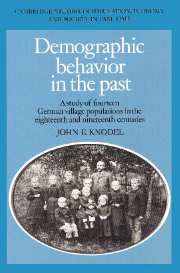 Demographic Behavior in the Past
Demographic Behavior in the Past Book contents
- Frontmatter
- Contents
- List of tables
- List of figures
- Acknowledgements
- PART I INTRODUCTION
- PART II MORTALITY
- PART III FAMILY FORMATION
- PART IV MARITAL REPRODUCTION
- 10 Trends in marital fertility and underlying natural fertility components
- 11 From natural fertility to family limitation
- 12 Starting, stopping, spacing and the fertility transition
- PART V INTERRELATIONSHIPS IN DEMOGRAPHIC BEHAVIOR
- PART VI CONCLUSION
- Appendices
- Bibliography
- Index
10 - Trends in marital fertility and underlying natural fertility components
Published online by Cambridge University Press: 04 August 2010
- Frontmatter
- Contents
- List of tables
- List of figures
- Acknowledgements
- PART I INTRODUCTION
- PART II MORTALITY
- PART III FAMILY FORMATION
- PART IV MARITAL REPRODUCTION
- 10 Trends in marital fertility and underlying natural fertility components
- 11 From natural fertility to family limitation
- 12 Starting, stopping, spacing and the fertility transition
- PART V INTERRELATIONSHIPS IN DEMOGRAPHIC BEHAVIOR
- PART VI CONCLUSION
- Appendices
- Bibliography
- Index
Summary
It is now well established that the reduction in fertility associated with the demographic transition in Europe was primarily a matter of changing reproductive behavior within marriage. While non-marital fertility also declined during the period of fertility change, it never constituted a large proportion of overall fertility, except in a few regions. Moreover, to the extent that nuptiality changed during the period of fertility decline, it generally increased, thereby counteracting rather than facilitating the trend to lower levels of reproduction.
In the sample of German villages on which this study is based, non-marital fertility has not been measured directly. However, the rise in illegitimacy ratios and their subsequent decline after the mid-nineteenth century probably reflect corresponding trends in non-marital reproduction. Even at their peak, illegitimate births never represented as much as 15 percent of all births, at least for the six fully-coded villages. Data on age at first marriage suggest that changes in nuptiality over the eighteenth and nineteenth centuries in the sample villages were fairly minor and thus cannot have had much impact, either on trends in overall fertility for the village populations as a whole, or on fertility differentials among the major occupational subgroups. No information on the proportions married, an aspect of nuptiality which could potentially change independently of the age at marriage, is available from the village genealogies.
- Type
- Chapter
- Information
- Demographic Behavior in the PastA Study of Fourteen German Village Populations in the Eighteenth and Nineteenth Centuries, pp. 247 - 286Publisher: Cambridge University PressPrint publication year: 1988


